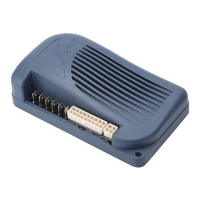Curtis 1228 Manual, Rev. F
11
2 — INSTALLATION & WIRING: Throttle
Voltage throttles with less than 5 V total voltage change over the full
stroke can be accommodated by programming the controller for reduced-range
throttle inputs, via the throttle gain parameter (see page 25).
Because the throttle input voltage is referenced to B- and no throttle con-
nections are made to the pot high and pot low pins, throttle fault protection is
lost with 5V throttles. The controller will not recognize out-of-range throttle
inputs as faults, and applying excessive voltages to the throttle wiper input may
damage the controller. It is the responsibility of the vehicle manufacturer
to provide throttle fault detection for 5V throttles.
Curtis ET-XXX Electronic Throttle
The recommended wiring for the Curtis ET-XXX electronic throttle is shown
in Figure 7. The ET-XXX throttle provides a single-ended 0–5V throttle signal
and a signal indicating whether it is in forward or reverse. The controller must
be programmed as a Type 4 throttle for use with the ET-XXX (see page 22).
As with any voltage throttle, there is no fault detection built into the
ET-XXX. It is the responsibility of the vehicle manufacturer to provide
throttle fault detection when using the ET-XXX.
Fig. 6 Wiring for 5V
throttle.
5V
THROTTLE
5V input (Pin 4)
Pot high output (Pin 3)
Pot low input (Pin 13)
4.7kΩ,
0.25W
resistor required with wigwag throttles
+
-
B-
Fig. 7 Wiring for Curtis
ET-XXX electronic throttle.
GREEN
ORANGE
BLACK
BLACK/WHITE
WHITE
WHT/BRN
B+
KEYSWITCH
connector
WHT/GRN
ET-XXX
ELECTRONIC
THROTTLE
B-
B-
Reverse input (Pin 17)
KSI input
(Pin 5)
5V input (Pin 4)

